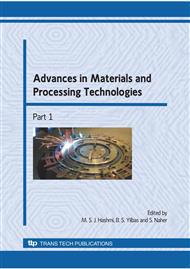p.1009
p.1016
p.1025
p.1035
p.1043
p.1051
p.1059
p.1069
p.1076
Development of Advanced Surface Engineering Technologies for the Benefit of Multipoint Cutting Tools
Abstract:
The benefits of applying advanced coatings on both single point and multipoint cutting tools such as improvement of productivity, tool life, machined surface quality etc. have been realised by the surface engineering researchers [1], commercial coaters [2-4] and end users [5]. The demand for advanced coatings in cutting tool industries is continually growing to meet the challenges of high speed machining, dry machining, near net-shape machining, machining of hard-to-cut materials etc.. Advanced coatings with excellent properties on flat coupon in a laboratory deposited by modern deposition technologies should not be taken for granted in improving the performance of complex shaped cutting tools [6] in aggressive cutting environments. This is because the end performance of coated cutting tools is not only dependant on the coating itself but also on the tool substrate material, geometry, surface finish and cutting edge conditions prior to coating deposition. The paper presents case studies with examples of successes and failures of advanced coatings on different multipoint cutting tools (e.g., milling cutters, bandsaws, circular saws, holesaws etc.). The future strategy for developing successful coating technology for cutting tools should be directed towards adopting a systems approach to bridge the communication gap amongst the cutting tool manufactures, tool coaters and end users.
Info:
Periodical:
Pages:
1043-1050
Citation:
Online since:
December 2009
Authors:
Keywords:
Price:
Сopyright:
© 2010 Trans Tech Publications Ltd. All Rights Reserved
Share:
Citation:


